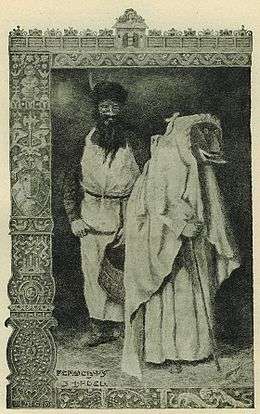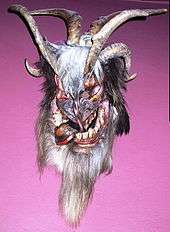Perchta
Perchta or Berchta (English: Bertha), also commonly known as Percht and other variations, was once known as a goddess in Alpine paganism in the Upper German and Austrian regions of the Alps. Her name may mean "the bright one" (Old High German beraht, bereht, from Proto-Germanic *brehtaz) and is probably related to the name Berchtentag, meaning the feast of the Epiphany. Eugen Mogk provides an alternative etymology, attributing the origin of the name Perchta to the Old High German verb pergan, meaning "hidden" or "covered".[1]

Perchta is often identified as stemming from the same Germanic goddess as Holda and other female figures of German folklore (see Frija-Frigg). According to Jacob Grimm and Lotte Motz, Perchta is Holda's southern cousin or equivalent, as they both share the role of "guardian of the beasts" and appear during the Twelve Days of Christmas, when they oversee spinning.[2][3]
Grimm says Perchta or Berchta was known "precisely in those Upper German regions where Holda leaves off, in Swabia, in Alsace, in Switzerland, in Bavaria and Austria."[4]
According to Erika Timm, Perchta emerged from an amalgamation of Germanic and pre-Germanic, probably Celtic, traditions of the Alpine regions after the Migration Period in the Early Middle Ages.[5]
Names of Perchta
Perchta had many different names depending on the era and region: Grimm listed the names Perahta and Berchte as the main names (in his heading), followed by Berchta in Old High German, as well as Behrta and Frau Perchta. In Baden, Swabia, Switzerland and Slovenian regions, she was often called Frau Faste (the lady of the Ember days) or Pehta or 'Kvaternica', in Slovene. Elsewhere she was known as Posterli, Quatemberca and Fronfastenweiber.[6]
The mother of the Franks emperor Charlemagne may have had a related albeit unwitted influence, as it did the Visigoth queen Brunhilda on her own, into its medieval folklore, Bertha or Berthrada was said to be of long and wide feet, in effect taller than her husband called precisely, Pippin the Short and may have been the reason why Charlemagne inherited from her his unusual height.
In southern Austria, in Carinthia among the Slovenes, a male form of Perchta was known as Quantembermann, in German, or Kvaternik, in Slovene (the man of the four Ember days). Grimm thought that her male counterpart or equivalent is Berchtold.[7]
Regional variations of the name include Berigl, Berchtlmuada, Perhta-Baba, Zlobna Pehta, Bechtrababa, Sampa, Stampa, Lutzl, Zamperin, Pudelfrau, Zampermuatta and Rauweib.
Description
In some descriptions, Perchta has two forms; she may appear either as beautiful and white as snow like her name, or as elderly and haggard.
In many old descriptions, Perchta had one large foot, sometimes called a goose foot or swan foot. Grimm thought the strange foot symbolized her being a higher being who could shapeshift to animal form. He noticed that Bertha with a strange foot exists in many languages (Middle German "Berhte mit dem fuoze", French "Berthe au grand pied", Latin "Berhta cum magno pede", Italian " Berta dai gran piè", title of a medieval epic poem of italian area): "It is apparently a swan maiden's foot, which as a mark of her higher nature she cannot lay aside...and at the same time the spinning-woman's splayfoot that worked the treadle".[8]
In the Tyrol she appears as little old woman with a very wrinkled face, bright lively eyes, and a long hooked nose; her hair is disheveled, her garments tattered and torn.[9]
Traditional narratives
Initially, Perchta was the upholder of cultural taboos, such as the prohibition against spinning on holidays.[10] In the folklore of Bavaria and Austria, Perchta was said to roam the countryside at midwinter, and to enter homes during the twelve days between Christmas and Epiphany (especially on the Twelfth Night). She would know whether the children and young servants of the household had behaved well and worked hard all year. If they had, they might find a small silver coin the next day, in a shoe or pail. If they had not, she would slit their bellies open, remove their stomach and guts, and stuff the hole with straw and pebbles. She was particularly concerned to see that girls had spun the whole of their allotted portion of flax or wool during the year.[9] She would also slit people's bellies open and stuff them with straw if they ate something on the night of her feast day, other than the traditional meal of fish and gruel.[4][9]
The cult of Perchta, under which followers left food and drink for Fraw Percht and her followers in the hope of receiving wealth and abundance, was condemned in Bavaria in the Thesaurus pauperum (1468) and by Thomas Ebendorfer von Haselbach in De decem praeceptis (1439).
Later canonical and church documents characterized Perchta as synonymous with other leading female spirits: Holda, Diana, Herodias, Richella and Abundia.
Related beings

Grimm thought Holda is her equivalent while the Weisse Frauen may derive directly from Berchta in her white form.
The word Perchten is plural for Perchta, and this has become the name of her entourage, as well as the name of animal masks worn in parades and festivals in the mountainous regions of Austria. In the 16th century, the Perchten took two forms: Some are beautiful and bright, known as the Schönperchten ("beautiful Perchten"). These come during the Twelve Nights and festivals to "bring luck and wealth to the people." The other form is the Schiachperchten ("ugly Perchten") who have fangs, tusks and horse tails which are used to drive out demons and ghosts. Men dressed as the ugly Perchten during the 16th century and went from house to house driving out bad spirits.[11][12]
Sometimes, der Teufel is viewed as the most schiach ("ugly") Percht and Frau Perchta as the most schön ("beautiful") Percht.
In Italy, Perchta is roughly equivalent with La Befana, who visits all the children of Italy on the night before 6 January to fill their socks with candy if they are well behaved or a lump of coal if they are not.[13]
Interpretations
According to Jacob Grimm (1882), Perchta was spoken of in Old High German in the 10th century as Frau Berchta and thought to be a white-robed goddess who oversaw spinning and weaving, like the myths of Holda. He believed she was the feminine equivalent of Berchtold, and was sometimes the leader of the Wild Hunt. However, John B. Smith disagrees and suggests that Perchta represents the personification of the feast of the Epiphany (Perchta's Day), and is therefore not pre-Christian.[14]
Modern celebrations
In contemporary culture, Perchta is portrayed as a "rewarder of the generous, and the punisher of the bad, particularly lying children".[14]
Today in Austria, particularly Salzburg, where she is said to wander through Hohensalzburg Castle in the dead of night,[15] the Perchten are still a traditional part of holidays and festivals (such as the Carnival Fastnacht). The wooden animal masks made for the festivals are today called Perchten.[12]
In the Pongau region of Austria large processions of Schönperchten ("beautiful Perchten") and Schiachperchten ("ugly Perchten") are held every winter. Beautiful masks are said to encouraging financial windfalls, and the ugly masks are worn to drive away evil spirits.[16]
Other regional variations include the Tresterer in the Austrian Pinzgau region, the stilt dancers in the town of Unken, the Schnabelpercht ("trunked Percht") in the Unterinntal region and the Glöcklerlaufen ("bell-running") in the Salzkammergut. A number of large ski-resorts have turned the tradition into a tourist attraction drawing large crowds every winter.
See also
Notes
- Mogk according to Natko.
- Grimm, 1882.
- Motz according to Hilton 1984.
- Grimm, 1882:272.
- Timm according to Natko.
- Ginzburg.
- Grimm 1882:279.
- Grimm 1882:280–81.
- Frazer 1920:240.
- Smith, John B. "Perchta the Belly-Slitter and Her Kin: A View of Some Traditional Threatening Figures, Threats and Punishments." Folklore 115.2 (2004): 167-86
- Frazer 1920:242-243
- Wagner 2007.
- Illes, p. 269.
- Hopkin, David. "Folklore and the Historian", The Folklore Historian, Vol. 17, Simon Bronner, 2000
- Vivian, Mrs. Herbert. "The Perchten Dancers of Salzburg", The Wide World Magazine: An Illustrated Monthly of True Narrative, Adventure, Travel, Customs and Sport, Vol. 21, 1908
- Gallon, Stephanie. "Christmas Demons II - Krampus and Perchta", International Gothic Association, December 18, 2014
References
- Frazer, Sir James George. 1920. The Golden Bough. A Study in Magic and Religion. IX. Part 6. "The Scapegoat", pages 240-243. Macmillan & Co. (Facsimili Elibron Classics, 2005) ISBN 1-4021-8348-8. (Online). File retrieved May 18, 2007.
- Grimm, Jacob (1882). Deutsche Mythologie 4th ed. [1875]. Trans. James Stallybrass Grimm's Teutonic Mythology Volume 1.
- Motz, Lotte. 1984. "The Winter Goddess", Folklore 95:11.
- Mogk, Eugen. 1907. Germanische Mythologie
- Müller, Felix and Ulrich. 1999. "Percht und Krampus, Kramperl und Schiach-Perchten." Wunderlich, Werner (Ed.): Mittelalter-Mythen 2. Dämonen-Monster-Fabelwesen. St. Gallen, S. 449-460. (Online, German) File retrieved May 18, 2007.
- Natko, David. 2014. Ritual Rebellion and Social Inversion in Alpine Austria: Rethinking the “Perchtenlauf” in its Relationship to the Carnivalesque. (Online). File retrieved 01-04-2015.
- Timm, Erika. 2003. Frau Holle, Frau Percht und verwandte Gestalten: 160 Jahre nach Grimm aus germanistischer Sicht betrachtet.
- Wagner, Alexander. 2007. Perchtenläufe: Salzburg's Pagan Heritage. (Online) File retrieved May 18, 2007.
- Waschnitius, Viktor. 1913. Perht, Holda und verwandte Gestalten: ein Beitrag zur deutschen Religionsgeschichte. Sitzungsberichte der Akademie der Wissenschaften in Wien, Philosophisch-Historische Klasse.
Further reading
- Hill, Thomas D. "Perchta the Belly Slitter and Án Hrísmagi: "Laxdœla Saga" Cap. 48-49." The Journal of English and Germanic Philology 106, no. 4 (2007): 516-23. www.jstor.org/stable/27712691.
- Smith, John B. "Perchta the Belly-Slitter and Her Kin: A View of Some Traditional Threatening Figures, Threats and Punishments." Folklore 115, no. 2 (2004): 167-86. www.jstor.org/stable/30035166.
External links
